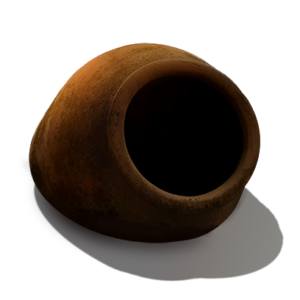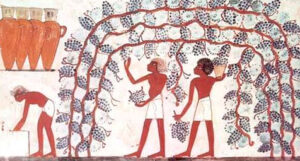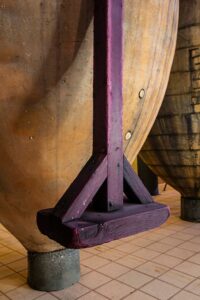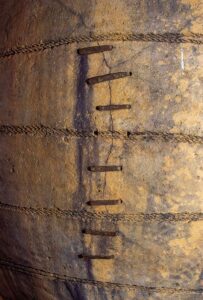What if we made wine the way it used to be, a wine crafted in clay amphorae? That was the question—or rather, the challenge—we posed at PRADOREY back in the summer of 2016. After an intense and fascinating internal debate, we decided to go for it. After all, every time we had done something different, it had worked out well for us.
There aren’t many records on how wine was made “the old way,” but a quick Google search for “origin of wine” offers several clues. Among them, countless references and illustrations show that clay amphorae were already being used in ancient Egypt around 3000 BC. Those images opened our eyes. Why not craft wine in an artisanal way, using the same ancient materials, without modern tools, and in centuries-old clay amphorae?
Finding century-old amphorae to make wine the old way
We had to act fast before harvest. We needed to find ancient amphorae (if they still existed!) and restore them in time for winemaking. We were advised to search in the province of Toledo, and there we found villages that were like living museums, filled with buried clay vessels (bernegales) in abandoned underground cellars, waiting fo
r someone to bring them back to life.
Excavating them was no easy feat, but in record time, we had our first four amphorae ready for the 2016 vintage.
That first harvest in clay was a whirlwind of emotions. Notonly did we stomp the grapes by foot, as was done in the past, but we also checked on the amphorae every four hours, stirring and tasting to ensure everything was progressing naturally. We added no artificial yeasts or chemicals and had no way to control the temperature. We were making wine just as our ancestors did.
There were many obstacles, but we overcame them with an artisan’s mindset. Soon, we were surprised by the expressiveness of the wines aging in the clay, and how different they were compared to sister grapes aged in stainless steel or barrels.
“This wine has soul,” said one of the first outsiders who dared to taste it. “It tastes like the village wine my grandfather used to give me.”
The amphorae revealed a pure wine, untouched by external influences, reflecting exactly what the vineyard had offered that year. From one of those amphorae, El Buen Alfarero was born, while the wines from the other three were used to continue learning from this fascinating process.
No artificial yeasts, no chemicals—this “soulful” wine was achieved another way
As we like to say, that first vintage aged in clay gave us one certainty (El Buen Alfarero, nominated as a Revelation Wine by the Peñín Guide) and countless questions.
- What exactly happens inside the amphorae?
- Are they compatible with barrels?
- How do different amphora sizes and shapes affect the wine?
- How does the wine “breathe” through the clay?
- Why does the wine “seep” through some amphorae?
Many hypotheses, a black box of unknowns… but above all, the realization that we were crafting a truly unique, old-world wine.
The GOVALMAVIN project: understanding the science behind clay amphorae
As we were reflecting on all these questions, we discovered the GOVALMAVIN project, led by the Wine Technology Platform (PTV). This initiative unites wineries and research institutions seeking to understand the science behind clay amphorae.
Through GOVALMAVIN, we joined 15 other entities, co-funded by the European Union and Spain’s Ministry of Agriculture, Fisheries, and Food (MAPA).
The goal? To valorize traditional materials for crafting high-quality wines—not just to enrich Spain’s wine offerings, but to reinterpret our most iconic varietals and reconnect with our winemaking heritage.
Among the key players in the project are:
- Wineries like PRADOREY, Celler del Roure, and Juan Carlos Sacha.
- Technical services such as Alfatec Ingeniería and Consultoría.
- Leading research institutions like VITEC (Wine Technology Institute), Miguel Hernández University of Elche, and the Association for Ceramic Industry Research (ITC-AICE).
Additionally, the Spanish Wine Market Observatory and the regulatory councils of Valencia and Uclés have joined as collaborators.
Every test has helped answer key questions about winemaking in clay
At PRADOREY, we have experimented with different internal coatings for the amphorae to prevent seepage without losing their unique winemaking properties.
Now, halfway through the GOVALMAVIN project, we can proudly say we are beginning to understand why certain things happen inside the amphorae. What was once a black box is now revealing its secrets—gradually, but steadily.
For our research on amphora coatings, we spent hundreds of hours testing natural alternatives like beeswax, colophony resin, and almond oil, applying them in various ratios and techniques. Each formula has delivered intriguing results that we continue to analyze with our research partners at AINIA and UVaMOX (University of Valladolid).
A vessel that allows wine to reveal itself—without filters, without touch-ups
Now, as the new harvest approaches, we look back at how much has changed since our first artisanal 2016 vintage. There are still many unanswered questions about amphorae and their impact, but we like to say:
“When wine ages in an amphora, it’s like having your photo taken with no filters or edits—it’s just you, as you are. When wine ages in a barrel, it’s like adding an Instagram filter or Photoshop edits. Used well, they enhance beauty, but too much can distort reality.”
Wine aged in amphorae has soul because it expresses itself honestly, capturing the true essence of the terroir. We always say that wine is like people—only by staying true to itself can it reveal its best version.
The clay revolution: not a trend, but a return to our origins
Years ago, a prestigious business school in Spain debated the key resource for sustained competitive advantage in today’s globalized market. Some argued for technology, but others countered that technology can always be copied. Others emphasized “speed to market”—being the first to create, not just follow trends.
The final consensus? The most valuable resource is learning—and the ability to transform that knowledge into solutions that create value.
And that is exactly what matters most in this journey. It’s not just about the amphorae themselves or El Buen Alfarero, a wine that has brought us much joy. It’s about everything we’ve learned about how clay can imp
Today, most of our wines age in clay amphorae. This has led us to reinvent our Pradorey Roble, transforming it into ORIGEN—a more authentic, characterful wine. We’ve elevated Adaro and Finca La Mina, and we have new projects in the works, some of which may take years to reach the market. El Sr. Niño, a wine that has surprised many, is just the tip of the iceberg.
A few years ago, who would have imagined macerating wine in a century-old clay amphora in Ribera del Duero?
21 clay amphorae, a revolution in Ribera del Duero
The four amphorae we first mentioned have now grown into a room with 21 clay vessels, playing a crucial role in PRADOREY’s winemaking renaissance.
This space has also become one of the most unique, mysterious, and fascinating places to visit in Ribera del Duero. We invite you to experience it—it’s truly one of a kind.
As we continue GOVALMAVIN, we have learned so much, but we still have more to discover. One thing is certain:
The clay revolution is not a passing trend. At PRADOREY, it’s here to stay. WELCOME TO THE NEW ERA OF CLAY.



